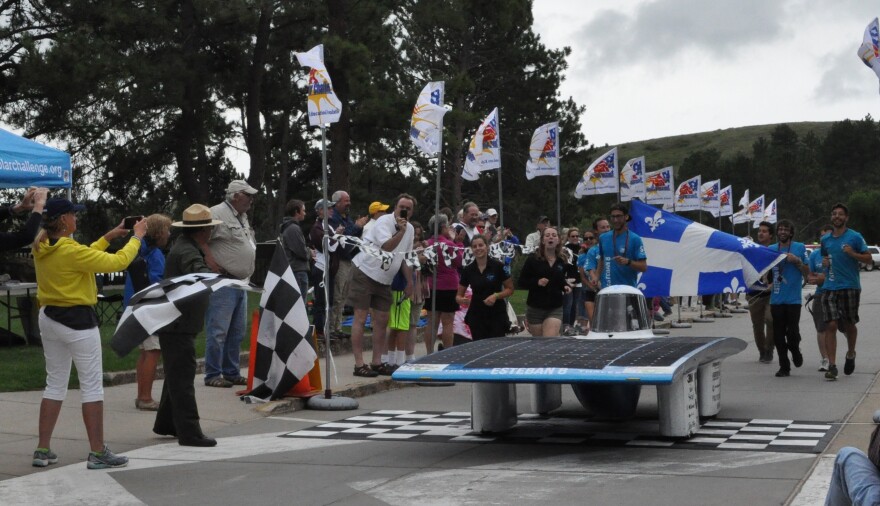If you’re listening to this show in the Black Hills right now there is chance you can also hear the rumble of a loud motorcycle. It’s the Sturgis Rally – and the thundering gas powered bikes are swarming the hills. Next we take a look at a much quieter form of transportation. A solar car race.
SDPB’s Jim Kent stopped by Wind Cave National Park for the closing hours of the American Solar Challenge Road Rally…on a very overcast Saturday morning as rain moved into the Black Hills.
There’s not a hint of sun in the cloud-covered sky as I drive through Wind Cave National Park and pull up in front of the Visitors’ Center.
Twenty-four flags line the primary lane to the center’s main entrance. They’re here to mark the way to the finish line for the 2016 American Solar Challenge 2016.
“The American Solar Challenge is a collegiate student design competition to design…build and the drive a solar powered vehicle on a predetermined route.”
That’s Gail Lueck. She’s spokesperson for the Innovators Educational Foundation which sponsors the event. Lueck says the primary goal of the challenge is to get students outside the classroom to engage in experiential learning.

“It’s not just an engineering competition…although there’s certainly a lot of engineering electrical design that goes into the vehicles,” Lueck explains. “But these teams also have to do their own fundraising. They have to manage their own logistics to get their fifteen to twenty person crew…you know...across the Midwest in hotels…lodging…food and all that. It’s really a…running a small business for two years to design and build a solar powered vehicle.”
Lueck says the requirements of the American Solar Challenge give students tools they need to succeed no matter what their future career field might be.
This year the American Solar Challenge route features the National Parks Service in honor of its centennial. Competing cars visited 9 NPS locations starting with the Cuyahoga Valley National Park in Brecksville Ohio and concluding here today in Wind Cave National Park near Hot Springs.
But at this point just what time that conclusion will come is anyone’s guess. Former solar car racer and event volunteer Paul Park says overcast skies that have plagued the competition in recent days are to blame.
“So…yesterday I believe all of the teams rode into the Scottsbluff stage area with almost empty battery packs…expecting that once they get there they’ll be able to charge a little bit and today will be a nicer day,” Park observes. “But…that wasn’t the case apparently. So they’re all crawling at…um….like the fastest speed they can muster at…28 miles per hour.”
Since Scottsbluff is about 150 miles away, it’s going to be…quite a while before the first car arrives.
“Thanks to everybody for coming out today,” the finish line judge announces “We appreciate you all coming out. The cars are moving slower right now because of the cloud cover. Solar car racing is not fast. We hope to have one soon. Thank you.”
The support crew turns on some appropriate music for the crowd that’s gathered; in this case The Beatles’ “Here Comes The Sun”. The crowd’s a mixture of locals, visitors to the cave and a few family and friends of the teams.
While we’re waiting…Paul Park offers some insight to the solar cars.

“Before the event begins they have about 4 days of racing that they need to do,” Park explains. “That determines the pole position for this road version of the race. And if they have a tie-breaker…whoever does the lap fast. So…sometimes solar cars will try to go as fast as possible but…these have maybe a 2 horsepower motors so…they’re quite slow compared to actual race cars.”
This is not Formula One racing…but some of the cars have reached 90 mph on the track. Their average cruising speeds on the open road generally fall between 50 to 60 mph when it’s sunny…which it’s not today.
But even when those rays are pouring down there’s still lots to be considered while driving what’s basically the equivalent of a giant solar panel on wheels. Assistance comes via radio from each car’s chase vehicle with instructions to adjust for wind from approaching tractor trailers…slow down or you’ll use up your battery…speed up or you won’t make it up that hill.
Overall says Paul Park it’s a complicated vehicle to drive and nowhere near the consumer-ready category yet.
As I approach the 3 hour standby mark there’s good news. The first solar car is in sight. And soon it’s crossing the finish line.
“We’d like to welcome Poly-Montreal Esteban into the finish line,” echoes from the loudspeaker as the crowd cheers and applauds. “Welcome Esteban!”

The solar car built by the Esteban team from Polytechnique Montreal…in Canada is today‘s winner. But since the actual rally winneris determined by the lowest overall lap time for the 8-day event the Michigan State University team receives the trophy at tonight’s banquet.
Notwithstanding, Esteban driver Samuel Tetrault-LeClerc is smiling.
“It was great,” say Tetrault-LeClerc laughing. “It was very nice to know ‘cause…we started last so we had to pass everyone. It was very cool.”
Like his team mates Samuel feels the best part of the experience was being able to see their engineering theories tested on the road. Getting to tour the American Midwest and visit the country’s national parks while advancing solar energy, he says, was just icing on the cake.
As I leave the Wind Cave Visitor’s Center and the next solar car approaches the finish line it’s now a rainy 2016 American Solar Challenge.
Related links:
The 2016 American Solar Challenge
http://americansolarchallenge.org/media/
The Polytechnique Montreal Esteban solar car team
https://www.facebook.com/VoitureSolaireEsteban/
The Michigan State University solar car team
http://www.solarcar.engin.umich.edu/
Wind Cave National Park
https://www.nps.gov/wica/index.htm

